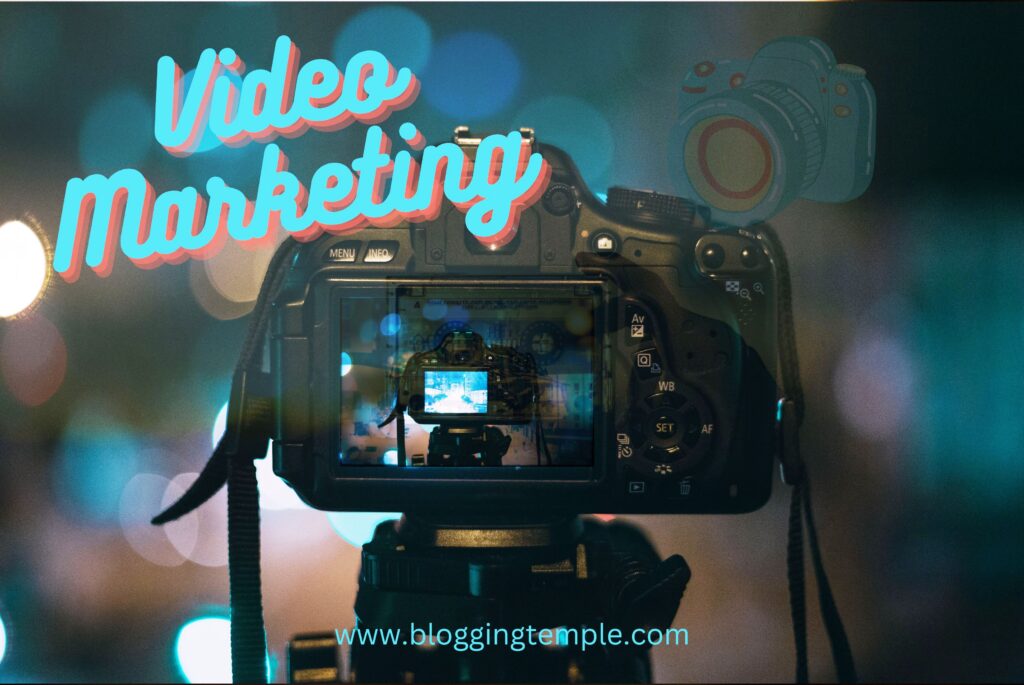In this Article, We have tried our best to provide you step by step knowledge of Video Marketing in digital marketing. By following valuable guidance of this article you will be able to make your own videos and also it will lead you to make a lot of money in US $. You can make social media videos that can be posted in your social media account that will help you to earn money. So follow the article from starting to end.
Table of Contents
Video Marketing: Unleashing the Power of Visual World
In today’s digital landscape, where information is consumed at an unprecedented rate, businesses need to find innovative ways to capture the attention of their target audience. With the ever-increasing popularity of online video content, video marketing has emerged as a powerful tool for businesses to engage, educate, and entertain their viewers. In this comprehensive guide, we will explore the world of video marketing and delve into effective strategies that can help your brand soar above the competition.
Click Here to Learn Email Marketing: https://bloggingtemple.com/email-marketing-using-mobile

The Rise of Video Marketing
The exponential growth of video consumption has revolutionized the way we consume information online. According to recent statistics, online videos account for over 80% of all internet traffic. With platforms like YouTube, Facebook, and Instagram catering to billions of users, video marketing has become an essential avenue for businesses to reach and connect with their audience.
Engaging Your Audience with Compelling Video Content
Creating captivating video content is the key to successfully engaging your audience. To ensure your videos resonate with your viewers, it’s crucial to develop a well-crafted script that tells a compelling story. A strong narrative combined with stunning visuals can captivate your audience from the first frame, keeping them hooked until the very end.
Learn more to Improve your knowledge: https://www.binaryeducation.in/
To record videos, follow these steps–
Choose a recording device:
Decide whether you’ll use a smartphone, digital camera, webcam, or dedicated video camera for recording. Ensure the device has suitable video quality and audio capabilities.
Plan your video:
Determine the purpose, content, and structure of your video. Prepare a script or outline to guide your recording.
Find a suitable location:
Select a well-lit and quiet environment for recording. Consider the background and ensure it complements the content of your video.
Set up the equipment:
If using a camera or webcam, mount it on a stable surface or tripod. Position the camera at eye level or at an angle that best captures the subject. Check the framing and ensure you have a clear view of what will be recorded.
Check lighting:
Make sure the subject is well-lit and visible. Natural light or a combination of natural and artificial light sources can provide good lighting conditions. Avoid backlighting or harsh shadows on the subject.
Test audio quality:
If using a separate microphone, connect it to your recording device and check the audio levels. Test the audio quality to ensure clear and balanced sound. Minimize background noise as much as possible.
Adjust camera settings:
Set the video resolution, frame rate, and any other relevant settings based on your recording device’s capabilities and the intended use of the video.
Familiarize yourself with the controls:
Understand how to start, stop, and pause the recording on your device. Learn how to adjust focus, exposure, and other settings if available.
Perform a test recording:
Before recording the actual content, do a short test recording to ensure everything is working properly. Review the test recording to check for any issues with audio, lighting, or framing.
Start recording:
When you’re ready, start the recording and deliver your content based on the script or outline you prepared. Speak clearly and maintain good eye contact with the camera if addressing the audience directly.
Monitor the recording:
Keep an eye on the recording device or use a monitor to ensure the video is being captured correctly. Monitor audio levels and adjust as needed during the recording.
Pause and resume if necessary:
If you need to take breaks or make adjustments during recording, pause the recording rather than stopping it completely. This makes editing easier later on.
Record multiple takes if needed:
If you’re not satisfied with a particular take, pause the recording and redo the section until you’re happy with the result. This allows you to choose the best footage during the editing process.
End the recording:
When you’ve finished recording all the necessary content, stop the recording on your device. Double-check that the recording has been saved properly.
Review and backup:
Playback the recorded video to ensure the quality meets your expectations. Make backup copies of the recording to prevent accidental loss or damage.

Optimizing Video Content for Search Engines
While creating high-quality video content is important, it’s equally crucial to optimize it for search engines. Implementing effective SEO techniques can significantly improve the visibility of your videos in search engine results pages (SERPs). Here are some strategies to consider:
- Keyword Research: Conduct thorough keyword research to identify the terms and phrases your target audience is using to search for relevant content. Incorporate these keywords naturally into your video title, description, and tags.
- Video Descriptions: Craft detailed and keyword-rich descriptions for your videos. These descriptions provide valuable context to search engines and viewers alike, helping them understand the content and relevance of your video.
- Transcriptions and Closed Captions: Transcribing your video content and adding closed captions not only improves accessibility but also enhances search engine optimization. Search engines can index the text, making your videos more discoverable.
- Thumbnail Optimization: Choose visually appealing and relevant thumbnails that entice viewers to click on your video. A compelling thumbnail can increase click-through rates and improve your video’s overall visibility.
- Promotion and Link Building: Actively promote your videos across various online platforms, including your website, blog, and social media channels. Encourage viewers to share your videos, and engage with other content creators in your niche to build quality backlinks to your videos.
Measuring Success with Video Analytics
To evaluate the effectiveness of your video marketing efforts, it’s essential to monitor and analyze key performance metrics. By leveraging video analytics tools, you can gain valuable insights into viewer engagement, click-through rates, and conversion rates. This data enables you to refine your video marketing strategy, optimize your content, and drive better results.
Staying Ahead of the Curve
Video marketing is a dynamic field that continually evolves with advancements in technology and changes in consumer behavior. To stay ahead of the curve, it’s crucial to keep up with the latest trends and adapt your strategies accordingly. Embrace emerging video formats such as live streaming, 360-degree videos, and interactive experiences to deliver immersive content that captivates your audience.
Modes of Video Marketing: Reaching Your Audience Effectively
Video marketing offers various modes and channels through which businesses can deliver their message to their target audience. By understanding and leveraging these modes, businesses can effectively engage viewers and maximize the impact of their video marketing efforts. In this article, we will explore different modes of video marketing and how each can be utilized to reach and resonate with the intended audience.
1. Website Integration
Integrating videos into your website is a powerful way to captivate visitors and provide them with dynamic and engaging content. Placing videos on your homepage, product pages, or landing pages can help communicate your brand story, showcase products or services, and increase visitor engagement. By strategically placing videos throughout your website, you can enhance the user experience and encourage visitors to spend more time exploring your offerings.
2. Social Media Platforms
Social media platforms offer a vast and highly engaged audience, making them ideal for video marketing. Platforms such as Facebook, Instagram, Twitter, LinkedIn, and TikTok provide opportunities to share videos organically or through paid advertising. Each platform has its own unique audience and content format, so it’s important to tailor your videos to fit the platform’s characteristics and preferences. Social media videos can help generate brand awareness, drive engagement, and encourage sharing among users.
3. YouTube Channel
YouTube, the world’s largest video-sharing platform, offers businesses a dedicated channel to host and showcase their video content. Creating a branded YouTube channel allows you to build a subscriber base, reach a global audience, and optimize your videos for search engine visibility. YouTube videos can be integrated into your website, shared on social media, or even monetized through ads or partnerships. With effective optimization and consistent content creation, YouTube can become a valuable platform for driving traffic, brand recognition, and customer engagement.
4. Email Marketing
Email marketing remains a powerful tool for nurturing customer relationships and driving conversions. Including video content in your email campaigns can significantly boost open rates, click-through rates, and overall engagement. Rather than relying solely on text, incorporating video snippets or thumbnails in your emails can capture the attention of recipients and encourage them to click through to watch the full video. Video content in emails allows you to convey messages more effectively, showcase products, and provide personalized and interactive experiences.
5. Video Advertising
Video advertising provides businesses with opportunities to reach a targeted audience through pre-roll ads, mid-roll ads, or display ads on various platforms. Platforms like Google Ads, Facebook Ads, and LinkedIn Ads offer robust targeting options to ensure your video ads are displayed to the right people at the right time. Video ads can help raise brand awareness, drive traffic to your website, and promote specific products or services. By creating compelling and concise video ads, businesses can capture the attention of viewers and entice them to take action.
6. Webinars and Live Streaming
Webinars and live streaming enable businesses to connect with their audience in real-time, fostering interaction and engagement. Hosting live webinars or streaming events on platforms like Zoom, YouTube Live, or Facebook Live allows you to present educational content, conduct product demonstrations, or engage in Q&A sessions. Live streaming humanizes your brand, encourages audience participation, and builds trust through authentic and interactive experiences.
7. Influencer Collaborations
Partnering with influencers in your industry can significantly expand your reach and credibility. By collaborating with influencers who align with your brand values and target audience, you can tap into their established following and leverage their influence to promote your video content. Whether it’s through sponsored videos, product reviews, or guest appearances, influencer collaborations provide an opportunity to reach new viewers and gain valuable social proof.

Exploring Different Types of Video Marketing
Video marketing encompasses a wide range of formats and strategies that businesses can leverage to engage and connect with their target audience. In this article, we will dive into various types of video marketing and explore how each can be used to convey messages, showcase products or services, and build brand awareness.
1. Explainer Videos
Explainer videos are concise and engaging videos that aim to educate viewers about a specific product, service, or concept. They provide a clear and concise explanation, often using animations, graphics, or live-action footage, to simplify complex ideas and capture the audience’s attention. Explainer videos are commonly used on websites, landing pages, and social media platforms to introduce a brand or highlight the key features of a product.
2. Product Demonstration Videos
Product demonstration videos allow businesses to showcase their products in action. These videos provide a visual demonstration of how a product works, its benefits, and how it can solve a customer’s problem. By highlighting the unique features and demonstrating real-world applications, businesses can effectively communicate the value of their products and increase consumer confidence.
3. Testimonial and Case Study Videos
Testimonial and case study videos are powerful tools for building credibility and trust. These videos feature satisfied customers sharing their positive experiences and outcomes with a particular product or service. By showcasing real-life success stories, businesses can establish social proof and inspire confidence in potential customers. Testimonial and case study videos are often used on websites, landing pages, and social media to influence purchasing decisions.
4. Brand Storytelling Videos
Brand storytelling videos go beyond the promotion of products or services and focus on conveying the brand’s values, mission, and unique identity. These videos aim to create an emotional connection with the audience by sharing captivating narratives, inspiring stories, or highlighting the brand’s journey. Brand storytelling videos help humanize the brand and foster a deeper relationship with the target audience.
5. Tutorial and How-To Videos
Tutorial and how-to videos provide step-by-step instructions on various topics, ranging from DIY projects to software tutorials. These videos offer valuable educational content, positioning the brand as an expert and resource in its industry. By addressing common pain points and providing solutions, tutorial and how-to videos can attract a wide range of viewers and establish the brand’s authority.
6. Live Videos and Webinars
Live videos and webinars enable real-time interaction and engagement with the audience. Businesses can host live events, presentations, or Q&A sessions to connect with their viewers, answer questions, and provide valuable insights. Live videos and webinars create a sense of authenticity and exclusivity, fostering a stronger relationship with the audience.
7. Behind-the-Scenes Videos
Behind-the-scenes videos offer a glimpse into the inner workings of a brand, showcasing the people, processes, and culture behind the scenes. These videos provide a transparent and authentic perspective, allowing viewers to connect on a more personal level. Behind-the-scenes videos can be shared on social media platforms or incorporated into brand storytelling to humanize the brand and build trust.
8. Animated Videos
Animated videos utilize captivating visuals, colorful characters, and dynamic storytelling to convey messages in a creative and engaging way. They are highly versatile and can be used to explain complex concepts, entertain, or add a touch of whimsy to the brand’s communication. Animated videos appeal to a wide range of audiences, making them an effective tool for capturing attention and leaving a lasting impression.
Q1: What is video marketing?
A: Video marketing refers to the use of videos to promote or market a product, service, or brand, typically through digital platforms.
Q2: Why is video marketing important?
A: Video marketing is important because it helps businesses engage with their target audience in a more captivating and memorable way. Videos can convey messages effectively, increase brand awareness, drive conversions, and enhance overall marketing efforts.
Q3: What are the benefits of video marketing?
A: Some benefits of video marketing include increased audience engagement, improved brand visibility, higher conversion rates, better search engine visibility, and the ability to convey complex information more easily.
Q4: How can I create effective videos for marketing purposes?
A: To create effective marketing videos, it’s important to define your target audience, plan your content strategy, keep videos concise and engaging, tell a compelling story, showcase your brand identity, and optimize videos for different platforms and devices.
Q5: What types of videos work well for marketing?
A: Different types of videos can be effective for marketing, including product demonstrations, customer testimonials, explainer videos, behind-the-scenes footage, educational or tutorial videos, and entertaining or viral content.
Q6: Where can I promote my marketing videos?
A: You can promote your marketing videos on various platforms such as your website or blog, social media channels (like YouTube, Facebook, Instagram, LinkedIn), video-sharing platforms (such as Vimeo or TikTok), email marketing campaigns, and through paid advertising channels like Google Ads or display networks.
Q7: How can I measure the success of my video marketing efforts?
A: To measure the success of video marketing, you can track metrics such as views, engagement (likes, comments, shares), click-through rates, conversion rates, and the impact on overall marketing goals (such as increased website traffic or sales).
Q8: Are there any tools or software available for video marketing?
A: Yes, there are several tools and software available to assist with video marketing, including video editing software (like Adobe Premiere Pro or iMovie), analytics tools (such as Google Analytics or YouTube Analytics), and video hosting platforms (like Wistia or Vimeo).
Q9: How can I optimize my videos for search engines?
A: To optimize your videos for search engines, you can use relevant keywords in the video title, description, and tags, transcribe the video content, create an engaging thumbnail image, optimize the video’s metadata, and promote the video through social media and backlinks.
Q10: What are some common mistakes to avoid in video marketing?
A: Some common mistakes to avoid in video marketing include creating overly long videos, neglecting the importance of good audio quality, not targeting the right audience, ignoring video SEO practices, and failing to track and analyze the performance of your videos.


0 thoughts on “Video Marketing Tips & Techniques | A Dynamic Revolution in 21st Century”